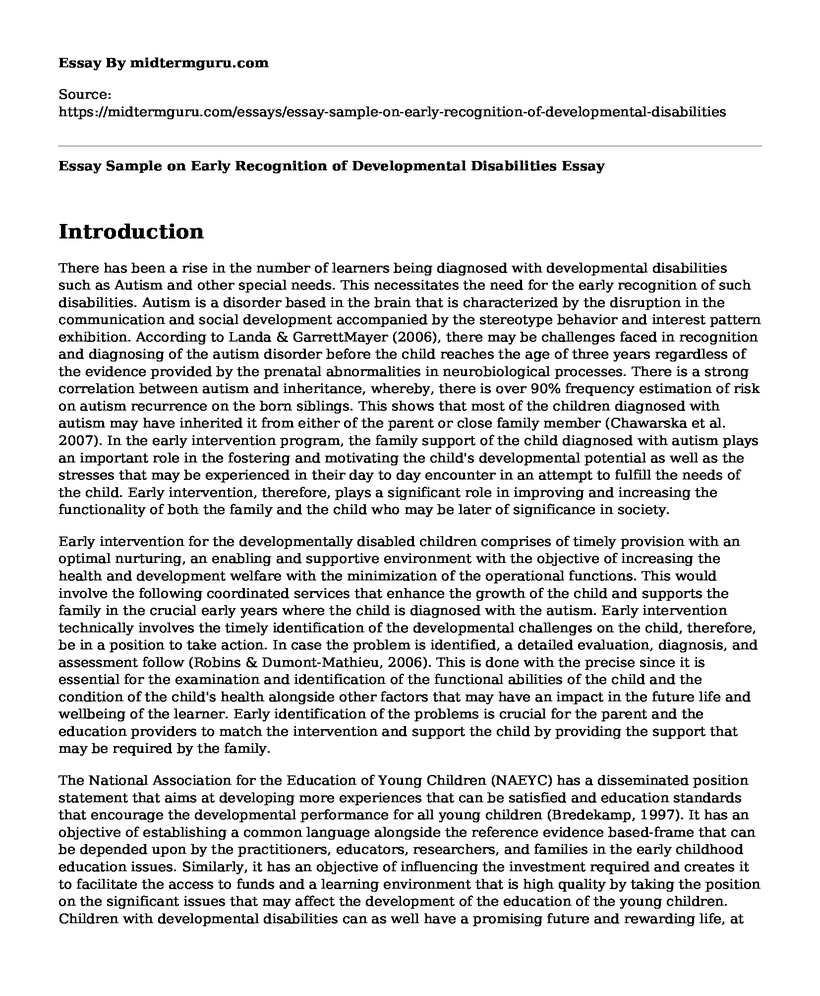Introduction
There has been a rise in the number of learners being diagnosed with developmental disabilities such as Autism and other special needs. This necessitates the need for the early recognition of such disabilities. Autism is a disorder based in the brain that is characterized by the disruption in the communication and social development accompanied by the stereotype behavior and interest pattern exhibition. According to Landa & GarrettMayer (2006), there may be challenges faced in recognition and diagnosing of the autism disorder before the child reaches the age of three years regardless of the evidence provided by the prenatal abnormalities in neurobiological processes. There is a strong correlation between autism and inheritance, whereby, there is over 90% frequency estimation of risk on autism recurrence on the born siblings. This shows that most of the children diagnosed with autism may have inherited it from either of the parent or close family member (Chawarska et al. 2007). In the early intervention program, the family support of the child diagnosed with autism plays an important role in the fostering and motivating the child's developmental potential as well as the stresses that may be experienced in their day to day encounter in an attempt to fulfill the needs of the child. Early intervention, therefore, plays a significant role in improving and increasing the functionality of both the family and the child who may be later of significance in society.
Early intervention for the developmentally disabled children comprises of timely provision with an optimal nurturing, an enabling and supportive environment with the objective of increasing the health and development welfare with the minimization of the operational functions. This would involve the following coordinated services that enhance the growth of the child and supports the family in the crucial early years where the child is diagnosed with the autism. Early intervention technically involves the timely identification of the developmental challenges on the child, therefore, be in a position to take action. In case the problem is identified, a detailed evaluation, diagnosis, and assessment follow (Robins & Dumont-Mathieu, 2006). This is done with the precise since it is essential for the examination and identification of the functional abilities of the child and the condition of the child's health alongside other factors that may have an impact in the future life and wellbeing of the learner. Early identification of the problems is crucial for the parent and the education providers to match the intervention and support the child by providing the support that may be required by the family.
The National Association for the Education of Young Children (NAEYC) has a disseminated position statement that aims at developing more experiences that can be satisfied and education standards that encourage the developmental performance for all young children (Bredekamp, 1997). It has an objective of establishing a common language alongside the reference evidence based-frame that can be depended upon by the practitioners, educators, researchers, and families in the early childhood education issues. Similarly, it has an objective of influencing the investment required and creates it to facilitate the access to funds and a learning environment that is high quality by taking the position on the significant issues that may affect the development of the education of the young children. Children with developmental disabilities can as well have a promising future and rewarding life, at the same, they are the most vulnerable in the society.
Reference
Bredekamp, S. (1997). NAEYC issues revised position statement on developmentally appropriate practice in early childhood programs. Young Children, 52(2), 34-40.
Chawarska, K., et al. (2007). Parental recognition of developmental problems in toddlers with autism spectrum disorders. Journal of autism and developmental disorders, 37(1), 62-72.
Landa, R., & GarrettMayer, E. (2006). Development in infants with autism spectrum disorders: a prospective study. Journal of Child Psychology and Psychiatry, 47(6), 629-638.
Robins, D. L., & Dumont-Mathieu, T. M. (2006). Early screening for autism spectrum disorders: update on the modified checklist for autism in toddlers and other measures. Journal of Developmental & Behavioral Pediatrics, 27(2), S111-S119.
Cite this page
Essay Sample on Early Recognition of Developmental Disabilities. (2022, Sep 25). Retrieved from https://midtermguru.com/essays/essay-sample-on-early-recognition-of-developmental-disabilities
If you are the original author of this essay and no longer wish to have it published on the midtermguru.com website, please click below to request its removal:
- Annotated Bibliography on the Relationship Between Single Mothers and Poverty
- Personal Interview Paper Example
- Paper Example on Health Alert: Junk Food and Malnutrition
- Prewriting Process Analysis: Life Challenges and Solutions
- Hospitals: Essential Social Institutions for Quality Healthcare - Essay Sample
- Pernicious Anemia: Causes, Symptoms, & Treatments - Research Paper
- Autism: From Refrigerator Mothers to Modern Causes - Essay Sample







